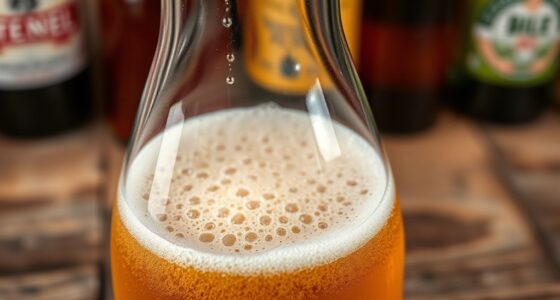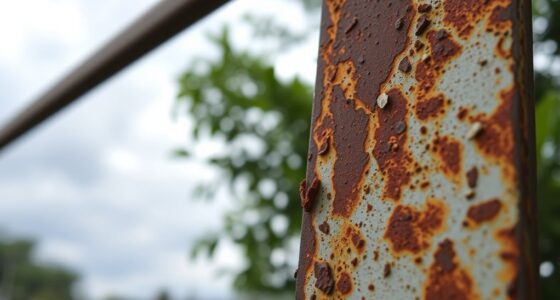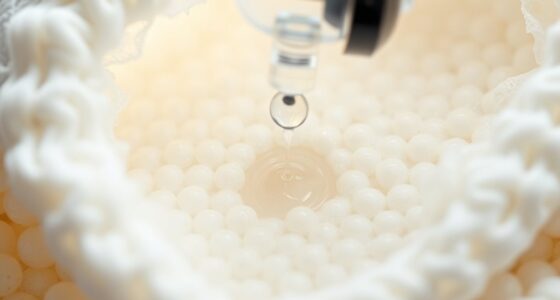The journey of chocolate from cacao to candy involves a series of chemical changes that develop its flavor and texture. You start with harvesting ripe cacao pods, then fermenting and drying the beans, which builds complex flavors through microbial activity and enzyme reactions. Roasting causes Maillard reactions that deepen aroma, while grinding and conching refine texture and mellow acidity. Proper tempering guarantees a shiny, smooth finish. If you want to explore how these processes create the chocolates you love, keep exploring further.
Key Takeaways
- Fermentation involves microbial activity that converts pulp sugars into ethanol, lactic acid, and acetic acid, initiating flavor development.
- Maillard reactions during roasting create complex aroma compounds and browning, shaping chocolate’s flavor and color.
- Enzymatic breakdown of proteins and polyphenols reduces bitterness and astringency, enhancing overall flavor quality.
- Cocoa butter crystallization during tempering stabilizes the chocolate’s structure and glossy appearance through specific crystal forms.
- The particle size reduction during grinding influences mouthfeel, while volatile compounds formed during processing contribute to aroma.
The Life Cycle of Cacao Trees and Harvesting Techniques

Cacao trees begin their life quickly, growing rapidly in their early years before they start producing beans around age five. They reach heights of about 15-25 feet, with a delicate structure that suits tropical climates. These trees can live up to 100 years, but their main productive phase lasts around 25 years. They require specific rainforest conditions, such as consistent humidity and shade, to thrive. They produce small, pink or white flowers directly on trunks and branches—a process called cauliflory. Not all flowers become pods; successful pollination by tiny midges is essential. Once pollinated, flowers develop into oval-shaped pods, which mature over 5-7 months. The timing of harvest is critical for ensuring quality, as pods ripen at different times during the year. Harvesting requires skill, as pods ripen at different times during the year. Careful timing and handling are crucial to maximize bean quality and ensure steady cacao production.
Fermentation and Drying: Building Flavor and Preserving Quality
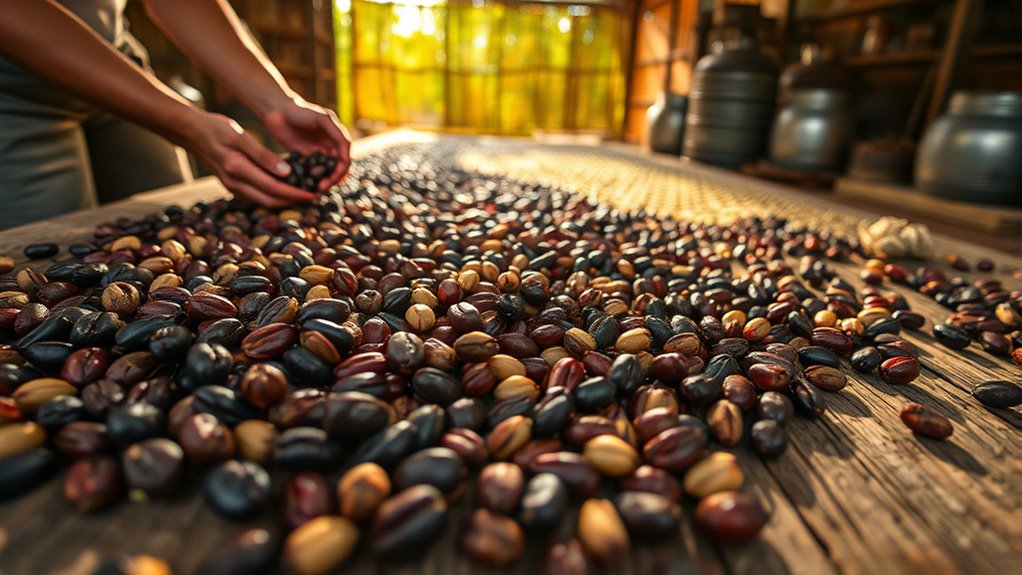
After harvesting the pods, the beans undergo fermentation—a vital step that shapes their flavor profile and preserves quality. Microbes drive this process: yeast converts pulp sugars to ethanol and CO₂, while lactic acid bacteria produce lactic acid, lowering pH. The fermentation process also reduces bitterness and astringency in the beans. Later, acetic acid bacteria oxidize ethanol to acetic acid, raising temperature to 50–55°C, activating enzymes that break down proteins and polyphenols into flavor precursors. Pulp liquefies as mucilage degrades, allowing aeration during turning. Fermentation lasts 5–7 days, with microbial succession influencing flavor development. Proper turning and temperature control guarantee uniform fermentation. Afterward, beans are sun-dried to 6–8% moisture, preventing mold and locking in color. This process balances acids and reduces bitterness, creating the foundation for complex cocoa flavors in your chocolate.
Roasting and Winnowing: Developing Aroma and Preparing Cocoa Nibs
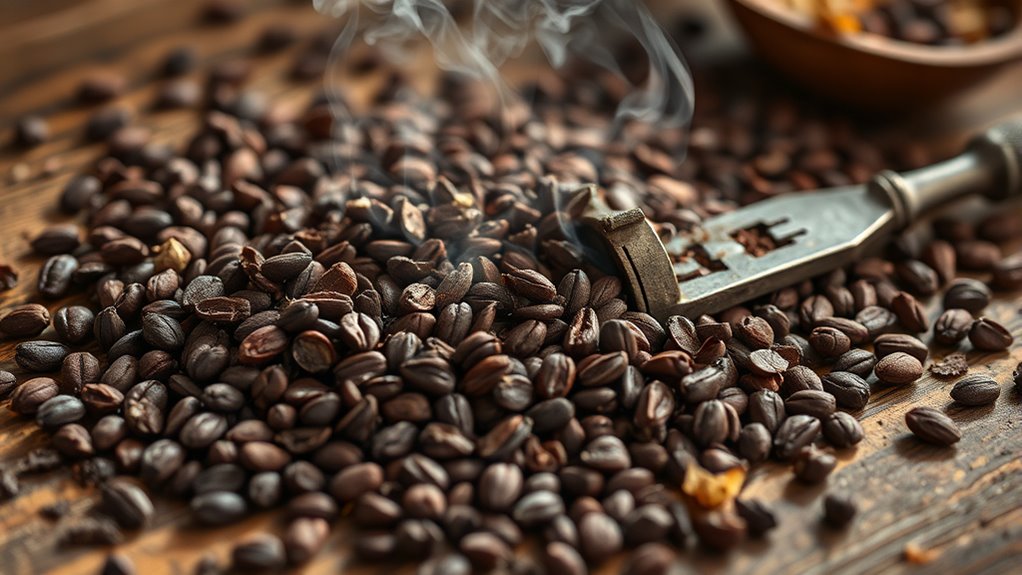
Roasting is an essential step that transforms raw cacao beans into fragrant, flavor-rich ingredients for chocolate. During roasting, you heat the beans between 250°F and 350°F for 12 to 35 minutes, depending on the desired flavor. This process causes the beans to crack, separating the husk from the nibs and promoting flavor development. Roasting enhances aroma through chemical reactions like the Maillard reaction, producing complex flavors and volatile compounds. Temperature and duration are critical factors that influence the final flavor profile; precise control ensures optimal results. Lighter roasts bring fruity and citrus notes, while darker roasts develop a more robust, bitter profile. Proper temperature and timing are critical to avoid over-roasting, which can create undesirable flavors. After roasting, you crack the beans and use airflow or mechanical means to winnow, removing shells and yielding cocoa nibs ready for further processing. Controlling chemical reactions during roasting is key to achieving desired aroma and flavor outcomes.
Grinding and Conching: Creating the Chocolate Base and Refining Texture

Grinding and conching are essential steps in transforming coarse cocoa nibs into smooth, flavorful chocolate. During grinding, you break down the nibs into a thick, gritty paste called cocoa liquor, reducing particle size to about 20 microns for a silky texture. Heat generated helps melt some cocoa butter, aiding flow and refinement, while releasing volatile flavors.
The result is a coarse chocolate base ready for conching. In conching, you heat, mix, and aerate the mass to remove volatile acids and moisture, mellowing sour notes. As you continue, the chocolate becomes more plastic, with cocoa butter coating particles and developing complex flavors through chemical reactions.
Viscosity increases, and residual acidity diminishes, producing a smooth, balanced, and glossy chocolate ready for the next stage.
Tempering and Molding: Achieving the Perfect Shine and Shape
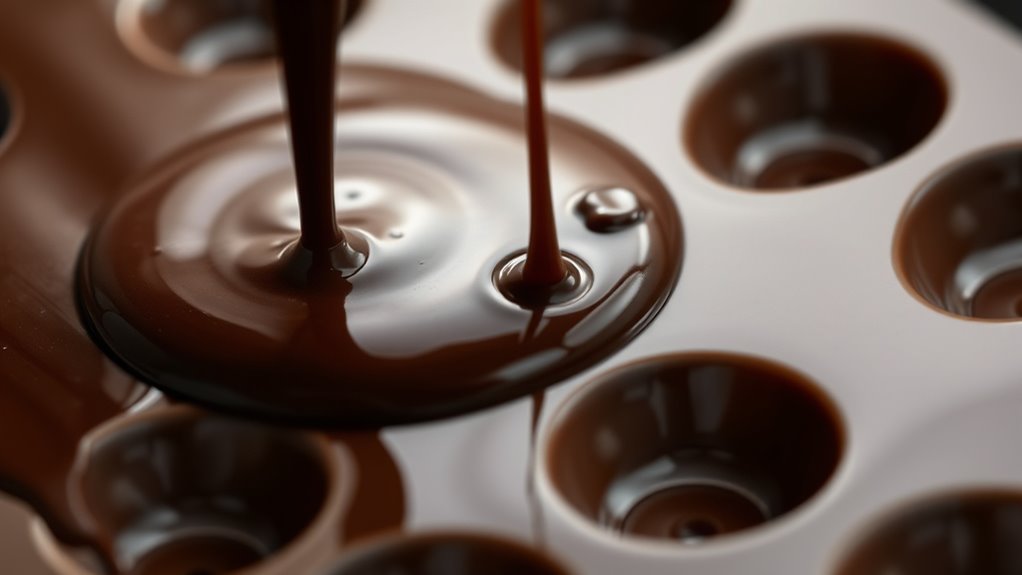
Achieving a glossy finish and perfect shape in chocolate hinges on the process of tempering, which controls the formation of stable cocoa butter crystals. You start by melting your chocolate to specific temperatures—110–115°F for dark, 105°F for milk and white—then cool it to 86–90°F while stirring. Adding pre-tempered seed chunks helps introduce stable Type V crystals, ensuring a shiny, firm result. Stirring evenly distributes these crystals, preventing streaks and uneven textures. Once tempered, pour the chocolate into polished molds kept above 86°F. Maintain a cool room (65–70°F) during setting to avoid bloom. Thin pieces set in 15–20 minutes; thicker items may need refrigeration. Proper tempering guarantees a smooth, glossy finish and well-defined shape, free from defects like bloom or cracks. Understanding crystal formation is essential for mastering chocolate tempering and achieving professional-quality results.
The Chemistry Behind Flavor Development in Chocolate

The development of chocolate’s rich and complex flavor hinges on a series of intricate chemical reactions that occur during processing. You’ll find that fermentation initiates this process, where bacteria produce precursors like amino acids and volatile compounds, laying the groundwork for flavor. During roasting, the Maillard reaction occurs, a key non-enzymatic browning that combines amino acids and sugars to create aroma compounds such as caramel and chocolate notes. Enzymes further break down components, releasing flavor-enhancing molecules. Over 400 volatile compounds, including aldehydes, ketones, and esters, contribute to chocolate’s diverse taste profile. These chemical transformations give chocolate its distinctive aroma, depth, and complexity, making flavor development a fascinating interplay of biology and chemistry that defines the essence of chocolate. Additionally, the specific tuning of fermentation and roasting processes can be optimized to influence these chemical reactions, further enhancing flavor characteristics.
Nutritional Components and Health Benefits of Chocolate

Chocolate isn’t only a delicious treat but also a source of numerous nutritional components that can benefit your health. It provides macronutrients like proteins, fats from cocoa butter, and carbohydrates, along with micronutrients such as iron, magnesium, copper, and manganese—especially in dark chocolate. Its high fiber content supports digestion, while antioxidants like flavanols help protect your cells from oxidative stress. Consuming dark chocolate may improve blood flow, lower blood pressure, and boost your mood thanks to phenylethylamine. Flavonoids in chocolate can enhance cognitive function by increasing blood flow to the brain. To maximize health benefits, opt for dark chocolate with high cacao content, enjoy it in moderation, and avoid chocolates with added sugars. Pairing it with fruits or nuts can further boost its nutritional value. Incorporating techniques to unlock creativity such as divergent thinking or cross-pollination can inspire new ways to enjoy or incorporate chocolate into healthy recipes.
From Bean to Bar: The Complex Journey of Chocolate Production
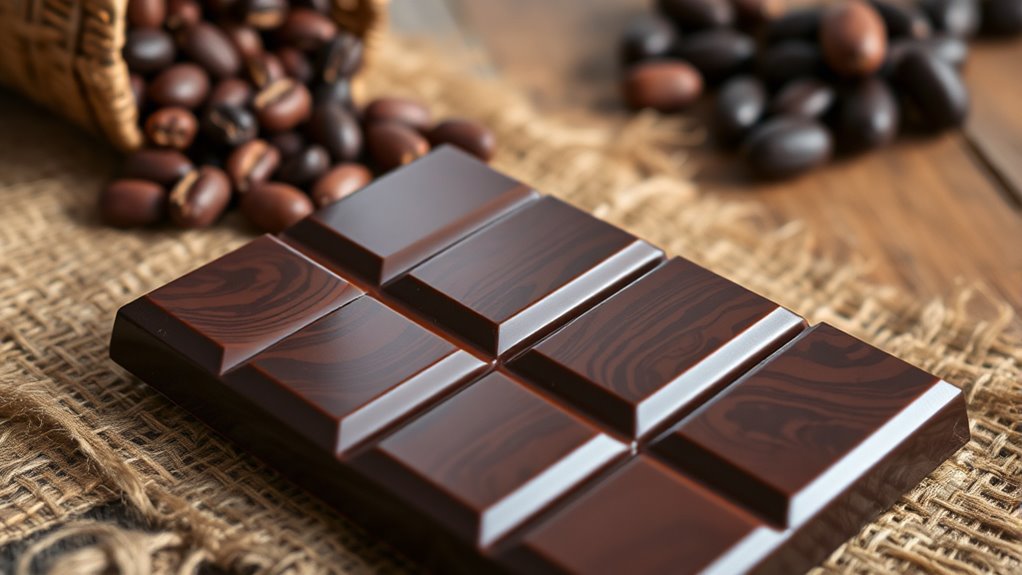
The journey from cocoa bean to bar involves a series of carefully controlled steps that transform raw pods into delicious chocolate. First, you harvest ripe cocoa pods, opening them to extract beans and pulp. These are placed in fermentation boxes, where yeast converts pulp into alcohol, generating heat, and regular stirring guarantees even fermentation. Necessary cookies in the process help optimize fermentation conditions and monitor quality control. After several days, the beans are sun- or machine-dried to reduce moisture and develop flavor. Next, the dried beans are sorted by quality and roasted at precise temperatures to enhance aroma. Winnowing separates shells from nibs, which are then ground into a chocolate liquor containing cocoa solids and butter. Finally, conching and tempering refine the flavor, texture, and appearance before pouring the chocolate into molds, cooling, and packaging the finished product.
Frequently Asked Questions
How Do Different Fermentation Durations Affect Chocolate Flavor Profiles?
You’re wondering how fermentation duration influences chocolate flavor. Shorter periods produce acidic, underdeveloped flavors, while ideal fermentation around 96 hours enhances fruitiness and nuttiness.
Extending fermentation beyond six days causes flavor degradation, off-odors, and rancidity. Proper timing ensures desirable aroma compounds and balanced flavors.
Too little or too much fermentation impacts aroma, taste, and texture, so controlling fermentation duration is key to achieving high-quality, flavorful chocolate.
What Role Do Polyphenols Play in Chocolate’s Health Benefits?
Polyphenols in chocolate boost your health by improving blood vessel function, lowering blood pressure, and supporting arterial elasticity.
They act as powerful antioxidants, neutralizing harmful free radicals and reducing oxidative stress.
These compounds also reduce inflammation and inhibit LDL cholesterol oxidation, lowering cardiovascular risks.
Consuming high-polyphenol chocolates can help protect against aging and chronic diseases, making your chocolate not just delicious but also beneficial for your overall well-being.
How Does Roasting Temperature Influence Cacao Bean Aroma Development?
You might think higher roasting temperatures only brown the beans, but they actually play a vital role in aroma development.
As you increase temperature, Maillard reactions and Strecker degradation intensify, creating complex aroma compounds like pyrazines, aldehydes, and furans. These molecules give chocolate its nutty, fruity, and caramel notes.
What Chemical Changes Occur During Conching to Improve Flavor?
During conching, you facilitate chemical reactions that refine chocolate flavor. Heating and mixing cause transformations in odor-active compounds, creating new, appealing aromas while reducing undesirable ones like off-flavors and acids.
These changes also alter how flavor molecules bind and release, enhancing smoothness and aroma perception. By controlling the process, you guarantee even flavor distribution and develop a well-rounded, high-quality chocolate profile that appeals to your senses.
How Do Tempering Techniques Impact Chocolate Crystallization and Texture?
You might think tempering only affects chocolate’s appearance, but it actually controls crystallization and texture. By heating and cooling carefully, you promote the formation of stable beta crystals, giving your chocolate a shiny look and firm, snappy feel.
Methods like seeding or tabling guide this process, ensuring your chocolate isn’t dull or soft.
Proper tempering guarantees a smooth, glossy finish and the right texture for perfect confections.
Conclusion
As you savor each piece of chocolate, remember it’s more than just a treat—it’s a journey from seed to sensation. Like a story woven with chemistry and care, every step transforms humble cacao into a symbol of indulgence and connection. Embrace the magic behind the process, knowing that each bite carries the legacy of nature, science, and craftsmanship. Ultimately, chocolate reminds us that even the simplest pleasures hold profound stories worth savoring.



